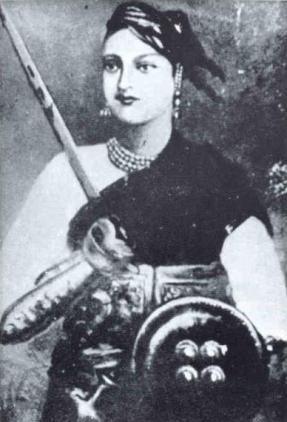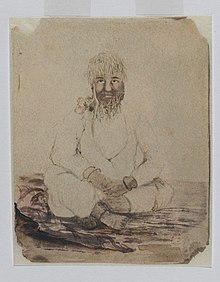
Lakshmibai Newalkar, the Rani of Jhansi, was the Maharani consort of the princely state of Jhansi in Maratha Empire from 1843 to 1853 by marriage to Maharaja Gangadhar Rao Newalkar. She was one of the leading figures in the Indian Rebellion of 1857, who became a national hero and symbol of resistance to the British rule in India for Indian nationalists.

Nana Saheb Peshwa II, born as Dhondu Pant, was an Indian aristocrat and fighter, who led the rebellion in Cawnpore (Kanpur) during the 1857 rebellion against the East India Company. As the adopted son of the exiled Maratha Peshwa Baji Rao II, Nana Saheb believed that he was entitled to a pension from the Company, but as he was denied recognition under Lord Dalhousie's doctrine of lapse, he initiated a rebellion. He forced the British garrison in Kanpur to surrender, then murdered the survivors, gaining control of the city for a few days. After a British force recaptured Kanpur, Nana Saheb disappeared, with multiple conflicting accounts existing of his further life and death.
Events in the year 1857 in India.

The siege of Cawnpore was a key episode in the Indian rebellion of 1857. The besieged East India Company forces and civilians in Cawnpore were duped into a false assurance of a safe passage to Allahabad by the rebel forces under Nana Sahib. Their evacuation from Cawnpore thus turned into a massacre, and most of the men were killed and women and children taken to a nearby dwelling known as Bibighur. As an East India Company rescue force from Allahabad approached Cawnpore, 120 British women and children captured by the rebels were butchered in what came to be known as the Bibighar Massacre, their remains then thrown down a nearby well. Following the recapture of Cawnpore and the discovery of the massacre, the angry Company forces engaged in widespread retaliation against captured rebel soldiers and local civilians. The murders greatly enraged the British rank-and-file against the Sepoy rebels and inspired the war cry "Remember Cawnpore!".
Narwar is a town and a nagar panchayat in Shivpuri district in the Indian state of Madhya Pradesh. Narwar is a historic town and the Narwar Fort is just east of the Kali Sindh River and is situated at a distance of 42 km from Shivpuri. Narwar was known as Narwar District during the times of Gwalior State. It is mentioned as Nalpura in many medieval Sanskrit inscriptions. The Narwar Fort is surrounded by the Kali Sindh River. There are three dams, Harsi Dam, Mohini Sagar and Atal Sagar. Presently the Fort is being renovated by the Archaeological Survey of India.

Bithoor or Bithur is a town in Kanpur district, 23.4 kilometres (14.5 mi) by road north of the centre of Kanpur city, in Uttar Pradesh, India. Bithoor is situated on the right bank of the River Ganges, and is a centre of Hindu pilgrimage. Bithoor is also the centre for War of Independence of 1857 as Nana Sahib, a popular freedom fighter who was based there. The city is enlisted as a municipality of Kanpur metropolitan area.
The Second Battle of Cawnpore was a battle of Indian Rebellion of 1857 that was decisive by thwarting the rebels' last chance to regain the initiative and to recapture the cities of Cawnpore and Lucknow.
The Central India Campaign was one of the last series of actions in the Indian rebellion of 1857. The British Army and Bombay Army overcame a disunited collection of states in a single rapid campaign, although determined rebels continued a guerrilla campaign until the spring of 1859.
Events in the year 1858 in India. Act of Parliament 1858

Jhansi Fort or Jhansi ka Qila is a fortress situated on a large hilltop called Bangira, in Uttar Pradesh. It served as a stronghold of the Chandela Kings in Balwant Nagar from the 11th through the 17th century.

Ek Veer Stree Ki Kahaani – Jhansi Ki Rani is an Indian historical drama based on the life of Lakshmi Bai, the Rani of Jhansi. The series was directed by Jitendra Srivastava and written by Rajesh Saksham, Ila Dutta Bedi, Malavika Asthana, Mairaj Zaidi and Virendra Singh Patyal. It premiered on 18 August 2009 on Zee TV with Ulka Gupta playing young Queen Lakshmi Bai. On 8 June 2010, the story moved on several years and Kratika Sengar portrayed the Queen from there on. The last episode aired on 19 June 2011, completing 480 episodes.
Nana Rao Park / Company Bagh is a public city park in Kanpur, the industrial hub of Uttar Pradesh, India, built after Indian independence in honor of Nana Sahib. Prior to Indian Independence the location was known as Memorial Well and commemorated the massacre of British women and children during the Indian Rebellion of 1857.

Orchha State was a kingdom situated in the Bundelkhand region and later a princely state in British India. The state was ruled by Bundela clan of Rajputs. It was located within what is now the state of Madhya Pradesh.

Jhansi was an independent princely state ruled by the Maratha Newalkar dynasty under suzerainty of British India from 1804 till 1853, when the British authorities took over the state under the terms of the Doctrine of Lapse, and renamed it the Jhansi State. Before the takeover, it was under the Peshwas from 1728 to 1804. The fortified town of Jhansi served as its capital.

Gangadhar Rao Newalkar was the 5th Raja of Jhansi situated in northern India, a vassal of Maratha Empire. He was a Marathi Karhade Brahmin. He was the son of Shiv Rao Bhau and a descendant of Raghunath Hari Newalkar.
The Bhat Peshwa family earlier known as Bhat family is a prominent Indian Chitpavan Brahmin family who dominated India for around 100 years in the late 18th century and early 19th century. Most of the members in this family were the Peshwas in the Peshwa Era of the Maratha Empire, and Peshwa later became their family name. During their regime, most of the Indian subcontinent was under their control. The last Peshwa, Baji Rao II, was defeated by the British East India Company in the Third Anglo-Maratha War in 1818. The territory was annexed to the British East India Company's Bombay Presidency, and he was pensioned.

Damodar Rao was the adopted son of Maharaja Gangadhar Rao and Rani Laxmibai of Jhansi State.

Newalkar dynasty were Marathi Karhade Brahmins, who were the Maharajas of Jhansi from 1769 to 1858. Their family deity was goddess Mahalakshmi. The Newalkars were sardars under Peshwa Madhavrao I, and later became Maharajas of Jhansi in Central India as an independent member of the Maratha Empire until 1818. Later, their kingdom became a princely state under the protectorate of British India.
Sachan is one of the territorial groups within the Kurmi caste in Uttar Pradesh, India.
Ali Bahadur II (1832–1873) was the last ruler (Nawab) of Banda. He decided to join the Indian Rebellion of 1857, he joined forces of Rani of Jhansi, Rao Sahib and Tantia Tope and was one of Major Commanders of Rebel force at Gwalior and in the aftermath his state was annexed by the British Raj. He also helped tatya tope in Siege of Charkhari.He surrendered in November 1858 and lived in exile at Indore with Pension of Rs. 36,000 per annum and he died in 1873. He was a descendant of Peshwa Baji Rao I and his Muslim wife Mastani.












